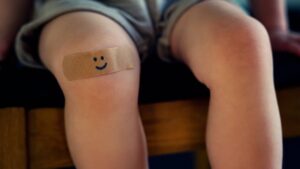Dr Boreham’s Crucible: Avita in for a busy 2020 with big expansion ambitions

Pic: Oscar Wong / Moment via Getty Images
At every investor presentation – and he’s fronted a few – Avita Medical (ASX:AVH) chief executive Dr Mike Perry includes a before-and-after picture of the visage of a 12-year-old girl who suffered burns to two-thirds of her body when her family’s Jeep crashed and exploded.
Two years later, the burns are barely discernible after the girl was treated with Recell, Avita’s spray-on skin product developed by Perth burns surgeon Professor Fiona Woods and famously used on the Bali terror bombing victims in 2002.
“You would normally be in hospital for three to four months and be fully scarred and disfigured for life,” Dr Perry says.
“Instead she was discharged after 23 days because the donor site is smaller. This is an amazing outcome.”
Australian burns technology aids volcano victims
Almost two decades on from the Bali incident that forged Recell’s reputation, burns treatment technology again has been cast into the limelight with New Zealand’s White Island volcanic eruption, which inflicted serious wounds on about 30 tourists.
Dr Perry said the company had offered Recell to the Australian and NZ hospitals treating the patients, with two US burns surgeons on standby. “They said it was not required at this point while the patients are being stabilised,” Dr Perry said.
In such situations deeper wounds might need a lattice-based product, along the lines developed by ASX counterpart Polynovo (ASX:PNV).
Polynovo reports that it has supplied its lattice repair product Novosorb Biodegradable Temporising Matrix (BTM) to three NZ and two Australian hospitals. “There are further surgeries scheduled for the week ahead and we will continue to work closely with the hospital teams,” the company says.
Both Avita and Polynovo were reluctant to discuss their involvement as they didn’t want to be seen to be benefiting from the tragedy.
Slow journey to top 200 status
Known as Clinical Cell Cultures up to June 2008, Avita has been a slow burn development-wise. In fact, the company looked to be going nowhere before the US Food and Drug Administration granted approval for burns indications in September 2018.
The company has been selling to US burns centres since January this year.
Since then the shares have risen seven-fold, culminating in a monster $120m capital raising (by way of an institutional placement) in November. A week earlier, the stock was promoted from the S&P/ASX300 index to the ranks of the top 200 stocks.
Dr Perry admits he felt like a rock star when he attended the American Burns Association annual get-together last April. “It felt like a Recell meeting, everyone was talking about us and it was a delight to be there,” he said.
As the market finally wakes up to Avita’s potential, the company is turning to other indications including paediatric scalds, diabetic and venous ulcer wounds and vitiligo.
Restoring the ‘glossy finish’
The Recell process involves cutting skin !!!!! taking a biopsy on any part of the body and mixing the cells into a liquid spray. It’s ready for use in 30 minutes and can cover 80 times the area of a skin graft with the same amount of material.
Because the nerves are usually damaged, the grafts – rather than the burns – create the most pain.
Dr Perry estimates that 53,000 patients are treated in-house, 75 per cent of them at one of 132 burns centres across the US (not a huge number given the country’s size and population).
Recell is effective for second or third-degree burns (partial thickness of skin burns), but if the burn is fourth degree (full thickness), a reconstruction is usually required.
Using a smash repair analogy, Dr Perry says Recell produces the glossy finish rather than removing the deep dents.
Deeper wounds might need a lattice-based product, such as Polynovo’s.
Dr Perry by the way is a former Novartis executive who came on board in mid-2017, replacing former war correspondent Adam Kelliher.
All of the company’s key ‘Cs’ – CEO, CFO (chief financial officer) and COO (chief operating officer) have been replaced. In November the CFO role turned over again with the appointment of former Heartware CEO David McIntyre.
The economics of Recell
The company is backed by the Biomedical Advanced Research and Development Authority (BARDA), the US agency that stockpiles medicine and medical equipment for use in a disaster.
BARDA has committed to up to $US80m ($117m) of funding for Avita’s burns trials and also plans to stockpile the product for a disaster.
BARDA also kindly stumped-up to fund an economic study, which showed that Recell would save healthcare dollars for any patients with bodily burns of 10 percent or greater. (Burns are measured by percentage, using the Wallace Rule of Nines, for head, chest, back, abdomen, lower back, arms and front and back of legs.)
The key to the savings is reducing hospital stays by 30 per cent and the number of surgeries by 30 to 40 per cent.
“It’s a better standard of care and we are saving the health care system,” Dr Perry says. “That’s because these donor sites are small and (grafts) are the main source of pain that keeps patients in hospitals longer.”
What’s next?
Avita cites a $US200m total addressable market for burns in the US, but it’s eyeing other indications to take the opportunities to well over $US2 billion.
One area is outpatient burns treatment. While the company is approved for this indication, it is not currently pursuing it because the kit requires two sets of hands.
“It’s perfect for the operating theatre but not the emergency room,” Dr Perry says. “We are in the process of creating that single-person, fully sterilised kit. We are working with [design house] Planet Innovation in Melbourne and we will be ready for submission by end of calendar 2020 or early 2021.”
The company plans to launch Brisbane-based trials for paediatric scalds, which in itself is a $US230m-a-year market.
Then there are trials for soft tissue repair after trauma such as bike accidents and gunshot wounds, as well as surgical wounds (such as those resulting from removing a tumour).
Combined, these are a $US750m market.
‘White leprosy’
But wait, there’s more: Avita is in early stage work with vitiligo, the genetic disorder that results in loss of pigmentation and skin turning white.
It’s also known as white leprosy or the Michael Jackson disease.
“We have treated 1,000 patients in China, we know it works,” Dr Perry says.
The company cites an addressable market of $US750m to $US1 billion.
In the US, Dr Perry says, 150,000 vitiligo patients are currently seeking therapy, but there are 6.5 million sufferers in all. “The reason there’s so few (seeking treatment) is that there’s nothing on the market currently to restore pigment to its original color and texture,” he says. (Clinuvel is working on it.)
In the genes
Actually, there’s even more!
In late November, Avita signed a collaboration deal with an esteemed US campus to further a spray-on treatment of genetically modified cells for epidermolysis bullosa.
A nasty rare disease, epidermolysis bullosa results from gene mutation and causes skin blistering, chronic wounds and even cancers.
The tie up is with the Gates Center for Regenerative Medicine at the University of Colorado School of Medicine.
“It’s the same process (as Recell); it’s just an additional step,” Dr Perry says.
Finances and performance
The Recell kits sell for $US7,500 each, with each unit covering 10 per cent of the body. So, a poor soul with 30 per cent burns would cost $US22,500 to treat.
Avita cites US sales of $10.8m to the end of September, with September quarter sales of $4.6m. This compares with sales of $2.9m in the fourth (June) quarter and $1.1m in the December 2018 quarter (when the company had not started selling in earnest).
Burns are seasonal in nature. Americans, for instance, are vulnerable to burns on July 4, when they’re lighting crackers after too many Budweisers.
Dr Perry says there are three main causes of burns: industrial accidents, domestic mishaps and “something beginning with ‘watch this!!’”
Avita shares have traded as low as 4.7c (mid-November 2017) and as high 71c (mid-November 2019).
Where to invade next
Recell is approved in Europe, Australia and China, but you’re not mistaken if you get the impression that the company is US-centric.
Because of the vagaries of reimbursement, Avita is not yet marketing in Europe.
“We are providing to European (burns) centres and keeping our licences current, but we are not actively selling,” Dr Perry says. “But we will re-launch in Europe when we add trauma (wounds) and vitiligo.”
China makes for a tempting opportunity, but there are problems. “It’s hard work and risky because they will figure out a way to reverse engineer your product and they don’t care about patents,” he says.
The company has a marketing distribution agreement with Japanese company Cosmotec, which is seeking approval from the country’s medical gatekeeper.
Dr Boreham’s diagnosis:
Avita’s 2020 ‘to do’ list involves plugging away at increasing its US burns business and furthering the trials for paediatric scalds, soft tissue wounds and vitiligo.
Beyond the aforementioned programs, Avita has its eye on the facial rejuvenation market, which could be worth many times that of all the other indications combined.
Move over Botox!
“We are working on an exclusive licence but I can’t say too much,” Dr Perry says.
“If we capture even just 5 per cent of this market, we are looking at well over half a billion dollars. And if we got to phase II without being acquired, I would be very surprised.”
Dr Perry can be proud of the corporate facelift he has engineered for Avita – on the proviso that revenue remains modest relative to the company’s $1.3 billion market valuation.
“We are a relatively small company with 100 people,” he says. “But we have a pipeline that is extraordinarily de-risked and looks like that of a mid-sized pharma company.”
Disclosure: Dr Boreham is not a qualified medical practitioner and does not possess a doctorate of any sort. He has no burning desire to light a bonfire with petrol; diesel is much safer.
This column first appeared in Biotech Daily.
Now tune into the latest Health Kick podcast:
More from Tim Boreham:
MedAdvisor could cure what ails it by shelving its expansion plans
Memphasys now feeling the investor love for its IVF tech
Visioneering is flexing its muscles as it vies for a share of the $US2bn kids contact lens market
UNLOCK INSIGHTS
Discover the untold stories of emerging ASX stocks.
Daily news and expert analysis, it's free to subscribe.
By proceeding, you confirm you understand that we handle personal information in accordance with our Privacy Policy.








